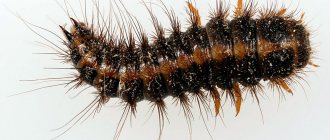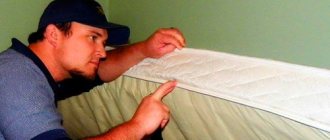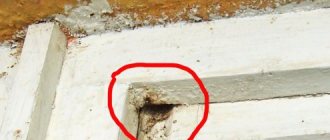The carpet beetle is difficult to find in modern apartments and private houses, but everyone should know that such an insect exists. It may appear, as always, unexpectedly. This pest prefers to feed on human skin, but does not refuse either indoor plants or various things located in apartments and of natural origin.
The carpet beetle prefers to be where people live. He likes being close to a person. If such a pest is discovered, it is necessary to immediately begin its destruction. The issue is quite serious and the recommendations should not be ignored.
Carpet beetle: description
The carpet beetle is considered one of the smallest pests, as it grows up to 1-2 mm in length. Therefore, it is not so easy to notice the pest with the naked eye, especially since the color camouflages it perfectly. At the same time, the shade of the pest can be either dark or light. The main color of the shell is brown, which allows it to camouflage against the background of furniture. The body of the beetle is distinguished by an oval, almost rounded shape, with the presence of barely noticeable stripes. There are also a lot of fibers on the body, and instead of a tail there is a long tuft.
Somewhere at the end of May, young individuals are born, since during this period insects mate and lay eggs. Prefers to settle in remote, dark places, such as basements, closets, warehouses. When beetles experience difficulties with food, they begin to move into human apartments. After laying eggs, red caterpillars are born three weeks later. Before a caterpillar becomes an adult, it goes through 6 stages of molting.
Adult specimens do not pose any danger to humans, as they feed mainly on plant sap. As for caterpillars, these voracious creatures feed on everything that may be in their path, and they can easily bite a person. The beetle can go without food for almost 5 years, falling into suspended animation.
How to deal with leather beetles in warehouses
Carpet beetles live in bakeries, granaries, grain processing plants, and warehouses with cereals, flour and animal feed. They contaminate and eat food, creating unsanitary conditions around them. As a result of research, it turned out that at the first degree of contamination of a room, up to 10% of the grain is damaged! Without a doubt, something urgently needs to be done about this.
The complex of protective measures against pests includes the treatment of all warehouses and non-warehouse reservations. Particular care must be taken in areas where pests have all the conditions for development and reproduction. The fight will be successful only under the condition of a strictly sanitary regime and compliance with all food storage rules.
The leather beetle in the granary is destroyed by wet disinfection. Unloaded warehouses are sprayed with a solution of fufanon, karate, standard - actellik, 200 ml of liquid is consumed per 1 square meter. The storage areas are treated with the same drugs, but doubling the liquid consumption.
Grain products and grains also undergo fumigation treatment. This is done in fuming chambers, cars, under film, freight cars, and sealed warehouses. Quickfos, magfos, agfos and dakfosal are used as fumigators.
In enterprises and warehouses, complete protection of products from beetle attacks is achieved only through a set of measures that complement each other.
It is extremely difficult to remove insects both in warehouses and at home. What difficulties await those who decide to wage an independent “war” against pests?
Interesting information
Getting rid of carpet beetles is not so easy, since their life activity includes some features. For example:
- Adults are active during the daytime, and in the evening they fly towards the light, so it is not difficult to fight them; it is enough to make primitive traps. As for caterpillars, this method is not suitable for destroying them.
- The larvae are afraid of sunlight, so they prefer to hide in dark, hard-to-reach places, which makes them difficult to find.
- These pests do not tolerate wet conditions, so regular wet cleaning helps to expel the carpet beetle from the apartment.
- Kozheed beetle larvae are more resistant to the action of special control agents compared to moths. Therefore, when destroying moths in an apartment, it is unlikely that you will be able to get rid of the skin beetle larvae.
- Caterpillars never rest and constantly move in search of food sources.
Skin beetle. Furry bugs in the apartment.
And finally - a little about prevention
After getting rid of the annoying pest, your main task is to prevent its reappearance. Below are must-have prevention tips:
- Clean the carpets in your apartment regularly. From now on, the vacuum cleaner is your main assistant in the apartment!
- Once a year it is necessary to disinfect suitcases with essential boric acid.
- Place wormwood and lavender on every clothing shelf—bugs hate these herbs.
- Keep as few old and unnecessary things as possible in your apartment.
- Check your clothing regularly.
- Buy vacuum bags and put clothes in them that you won't be wearing in the near future.
- The windows will have to be equipped with insect nets - they are excellent protection against skin beetles.
By regularly following all our advice, you will most likely be able to protect your apartment not only from disgusting skin beetles, but also from almost any other household pests!
Reasons for the appearance of skin beetles in an apartment
As a rule, people bring carpet beetles into their apartments themselves. Parasites prefer fur items, as well as accumulations of old books. The spread of insects throughout the apartment is often observed after cleaning a closet or warehouse, when the pests begin to hide in other places, away from bright light. When it’s warm outside, beetles have no problem entering apartments through open windows if they don’t have mosquito nets. They can often be seen in the spaces between window frames or in street lighting shades.
Types of skin beetles
To recognize the dangerous pests in the bugs crawling around your apartment, it is worth learning about the common types of skin beetles.
Kapra beetle
The nylon beetle (also called the grain beetle) has a 3 mm oval brown body and light hairs. The 5 mm larvae have red-brown hairs. For habitat it chooses cereals, nuts and dried fruits, loves meat and cheese products. The beetle is a carrier of infection. Lives more often in warm climates.
Spotted leather beetle
The spotted beetle is a leather beetle with an elongated light brown body of 9 millimeters. The larvae have a brown back, reddish-brown head and hairs.
The spotted skin beetle chooses the corpse of a mammal to live in; these bugs clean the bones for the museum. In the apartment, the larvae eat meat, fish, cheese, and milk powder.
Ham skin beetle
Ham skin beetles are oblong, a centimeter long, black in color with yellow hairs, and equipped with gray-yellow wings. The dark brown larvae have brown hairs on their bodies.
They choose open food products and do not refuse to chew wooden objects. The insect is prolific and easily penetrates living spaces.
Fur coat beetle
Harmless fur coat beetles choose dusty apartments because dust is food for them, just like human food. Doesn't eat fur coats. Oval, 6 mm body with a black head and chest, and brown elytra with white hairs or spots.
Carpet beetle
For 2-5 mm carpet beetle larvae, the treat includes carpets, dead human skin particles on bedding, crumbs, cat hair, as well as fur, skin and dust.
In addition, the larvae feed on feathers and down from pillows. The bug is brown or black in color; the adult insect uses up the reserve accumulated in the larval stage for life.
Brown leather beetle
The museum leather beetle, also known as the brownie, chooses indoor flowers and books for its habitat. Having settled in the museum, he chooses stuffed animals, leather book bindings, natural fabrics and paintings. Rarely found in residential areas. A beetle with an oval body of 3.5 mm, with black elytra and yellow hairs.
Smirnova beetle, Frisha, flower beetle
The 3 mm Smirnov beetle has a brown back. For living he chooses old wooden window frames and window sills.
Frisch's little black beetle rarely settles in apartments. If it appears, it chooses food.
The flower beetle is found on garden plants.
Is the carpet beetle dangerous for humans?
The carpet beetle is capable of feeding on a variety of foods such as wood, leather and other natural components. Carpet beetle larvae can feed on animal and plant sap. Unfortunately, the larvae of the carpet beetle can bite a person under certain conditions, although they do not purposefully attack a person, like bedbugs, for example. The danger lies in the fact that pests carry various viral and infectious diseases, including helminths.
In addition to the fact that the insect can bite a person, it causes significant damage to furniture and other household items. The beetle can infect large areas with pathogens of various diseases, which leads to serious consequences.
Skin beetle bites are usually quite harmless and do not cause any discomfort. But if a person is prone to allergic reactions, then large red spots with signs of swelling may appear at the bite sites.
Damage caused by beetles
For a significant portion of citizens, the leather beetle is an unfamiliar insect. Having no idea what this bug looks like, the owners cannot detect its presence in the house.
Smirnov's carpet beetle is a small insect, the length of which is about 5-10 mm. It has a strong brown shell, on top of which there are small stripes that stand out in color. The body has small villi. If you carefully examine the beetles, you will be able to detect a long, small tuft, similar to a tail. There are two most popular types: Smirnov’s leather beetle and ham beetle.
Finding uninvited guests in an apartment is not easy. They are often carried on clothes, shoes, flowers, and pets. They can easily penetrate an unclosed window.
.
These insects are nocturnal inhabitants that are not immediately detectable. Therefore, it is not always possible to take quick measures to exterminate them. As a result, skin beetles manage to lay eggs and gradually begin to capture “new territories.” Usually, owners become aware of the presence of skin beetles only after noticeable passages gnawed by insects begin to appear on furniture items. In addition, bite marks may appear on human skin.
The size of the beetle is small, but the harm from its activities can be serious. In particular:
- Material damage. This is due to the gluttony of insects, which begin to eat everything that, in our opinion, cannot be edible. Furniture, natural and leather fabrics are damaged. Carpets end up with bald spots after beetles. Uninvited guests are able to take a fancy to the sofa, and having made their way into the closet, they will hasten to spoil a significant part of the wardrobe there.
- Harm to the health of people living in the premises. Like all other insects, the skin beetle can provoke an allergic reaction. In addition, the pest can spread infectious diseases and bite strongly. The skin beetle larva is not blood-sucking, so it does not attack people.
The insect bite is usually not felt. There is slight redness in the affected area, and the area may itch. In people with sensitive skin, this redness will be more pronounced. Patients suffering from an allergic reaction also face a similar problem. In addition, swelling often appears at the bite sites.
Important! The carpet beetle is dangerous due to its ability to spread infections. The bite of this insect often causes human infection. Therefore, the affected area must be disinfected.
Thus, if an “unpleasant “neighbor” is found in the house, urgent measures must be taken. Not only adult representatives of this species are subject to extermination, but also larvae and eggs. There are many ways to fight parasites.
Effective methods of combating skin beetles
First of all, you need to find the place where the skin beetle larvae are hiding. As a rule, they can be found in hard-to-reach places where direct sunlight does not reach. Pests are distinguished by a certain cunning. If a clutch of eggs is detected, success is almost 100% guaranteed. In case of such luck, it is better to destroy the eggs immediately.
If the beetles were found in winter, then to destroy them it is enough to take things out into the cold.
Thorough cleaning of the room with a vacuum cleaner increases the chances of getting rid of such parasites, but does not provide a 100% guarantee. The larvae have a long development period, so after a few weeks the beetles may reappear in the apartment. To get rid of such parasites forever, it is better to use chemical means of control. Moreover, in retail outlets you can choose a drug, as they say, “for all occasions.”
How to get rid of beetle larvae
Chemical control agents
The following can be suggested as effective drugs:
- Product based on boric acid . The use of the drug is not difficult. It is enough to scatter it on the floor near the baseboards, on the window sills, next to the carpeting. This chemical does not pose a danger to humans, does not have a pungent odor and does not interfere with human life. But if small children and animals live in the house, then using the drug is prohibited. Significant harm should not be expected from boric acid-based powder, but food poisoning or allergic reactions are possible.
- Special solutions . They are recommended for use in cases of severe contamination of the premises. In such cases, it is recommended to treat the entire apartment, and not just individual rooms. Almost all solutions do not leave marks on furniture and other household items. This is how they deal with delicate items: they are wrapped in a bag along with a container in which the chemical is located. After a few hours, things can be unwound. They mainly use drugs such as “Executioner” or “Tetrix”. If everything is done responsibly and correctly, then you can get rid of the carpet beetle forever.
- Aerosols . These are the same insecticides contained in a pressurized can. Although the drugs are not as effective as special solutions, their use is justified in some cases. The action of the drugs is based on the fact that the substance penetrates the chitinous layer, which leads to paralysis of the insect and its death. Since the larvae do not have a chitinous layer, they die much faster. Preparations in the form of aerosols are cheaper, but they have a higher consumption. The drugs “Raptor”, “Raid”, “Clean House”, “Dichlorvos” and others are widely popular.
- Pills . Preparations in tablet form help fight moths, as well as carpet beetles. In this case, Fr. At the same time, tablets are more attractive to larvae, since adult individuals prefer food in liquid form. The use of tablets is considered as an adjuvant. Products in the form of tablets have a specific aroma and this factor must always be taken into account when choosing a pest control product.
Carpet beetles, having settled in an apartment, cause a lot of inconvenience to the residents. Due to their specific coloring, this pest is difficult to notice as they blend in with the shade of the furniture. Fighting such pests takes a lot of effort and resources. It is very important to destroy all the beetles, since even one larva, after some time, will give birth to offspring and the beetles will reappear in the apartment. The first signs of a carpet beetle appearing in the house, as evidenced by holes in the furniture or on the windowsill, indicate that it’s time to put aside everything in the house and start eliminating uninvited guests.
Treating a room, especially with chemical control agents, requires the use of personal protective equipment, such as gloves, goggles, a gauze bandage and a protective gown. During treatment, all residents, as well as animals and indoor plants, are evacuated from the premises. After treatment, it is not recommended to enter the room for some time, as indicated in the instructions.
Folk remedies
Folk compositions based on natural ingredients are not as effective as chemical agents, but they are suitable in cases where not many beetles have bred yet, and also as preventive measures. And although they will not be able to cope with the invasion of pests, they can scare them away. That's why:
- To repel pests, you should place cotton pads soaked in ethers of lavender, tansy, lemon balm, etc. in the kitchen. Many pests cannot tolerate such aromas.
- Carpet beetles, like most pests, die from the action of boric acid.
- The use of table vinegar also helps protect the apartment from many insects. To do this, take 1 liter of hot water and dissolve a tablespoon of vinegar in it. After this, the solution is poured into a spray bottle and areas such as window sills, baseboards, trim, shelves and cabinets are sprayed with it. The smell of vinegar will make uninvited guests look for a new, more comfortable place to stay.
Removing the leather beetle
Top 6 skin beetles by prevalence in Russia
The leather beetle family includes 600 species of beetles, many of them are morphologically similar to each other. However, out of all the variety of subfamilies and species, only seven are dangerous pests. They pose the most serious threat to food, things, and indeed the sanitary and epidemiological situation of the apartment as a whole. And it’s not so easy to find out what type of skin beetle the uninvited guest belongs to. To get rid of them, by and large, you don’t need to know this, because the tactics for exterminating all skin beetles are approximately the same.
There are 4-5 types that are comfortable in a city apartment. It should be noted that they can get along just fine without fur and with leather.
1. Ham skin beetle is the most common on the Eurasian continent. It can start in a person's house. The ham skin beetle is found quite often in apartments. The beetle is oblong in shape, black in color, with a yellowish-gray (or brown) part at the top of the wings.
2. Carpet beetles - this is the common name for a small group of 2-3 dark brown leather beetles, which are united by the fact that they are able to feed only on particles of house dust containing the smallest organic debris (fur coat beetles, carpet beetles, etc.). Often found in everyday life. Only the larvae feed; the adult beetle goes without food, using up its accumulated fat reserves.
Most likely, having discovered several such strange individuals, it will never occur to anyone that it is a skin beetle, especially if you do not know that it grows in houses. They are most often called by what they look like—little brown bugs.
3. Smirnov’s carpet beetle is a small brown bug reaching a maximum of 3 mm in length. It was brought to Russia about half a century ago, but during this time it managed to adapt to living in private houses and became a full-fledged synanthrope. It is this type of skin beetle that loves windows and window sills in apartments.
4. The fur coat beetle is a black spotted beetle with five small white spots on the back. It is not as harmful as other species, and is also quite rare in apartments. But if he gets into an apartment, he mostly eats food, but does not touch the products.
5. Museum and house leather beetles - they can live in flowers in apartments and houses, but are practically not found in home life, despite the fact that the name of the latter is “brownie”.
6. Frisch's carpet beetle is a black oval beetle; in our practice, there have been no cases of infestation of apartments with this species.
The most common species of carpet beetles in the European part of Russia and Siberia are the carpet beetle and the Smirnov carpet beetle. These are the so-called “little brown bugs on window sills and plastic windows.” But it is not uncommon for both ham and fur skin beetles to appear in the house (the latter of which is black spotted).
Carpet beetles are classified as pests of supplies and materials; in terms of their importance for household and industrial farming, as well as biology and behavior, they are quite similar to moths in many ways. This leads to similar tactics of extermination and struggle.
Are there any bugs? This means their larvae are somewhere. If you find these beetles hanging motionless on curtains, ceiling, etc. – these are also skin beetles. They may play dead by rolling over on their back, leading you to think they are not a threat. The constant presence of black or dark brown beetles (on plastic windows, frames, etc.) in an apartment tells us that some room is being damaged by larvae. This fact is an indisputable truth. This is similar to the conclusion that we are accustomed to making when we see moths flying, indicating that old clothes in a dusty mezzanine are certainly eaten by caterpillars.
Larvae . The presence of skin beetles can be determined by the hairy larvae with long, sometimes colored “tails.”
They are often confused with moth larvae in cabinets.
In an apartment, skin beetle larvae are often found in the sofa or some furniture. As a rule, larvae are discovered completely unexpectedly and by accident, and they are described as brown or striped worms. If there are worms in the sofa, this means that skin beetles have appeared in the apartment. The caterpillars in the sofa are the same skin beetle larvae. Pulling back the edge of the blanket, you can see these slightly light larvae on the mattress.
Treatment of carpet beetle bites
Despite its very small size, the carpet beetle bites quite painfully. Young children and women react especially violently to its bites. In addition, they can infect humans with serious infectious and viral diseases. Therefore, it is very important to immediately treat the bite site with a disinfectant such as hydrogen peroxide. If this does not help and the bite site begins to become inflamed, it is better to consult a doctor immediately.
To prevent an allergic reaction, you need to take an antihistamine, such as Diazolin. The wound site can be treated with moisturizing creams, which speeds up the healing process. If everything is done on time and correctly, then there should be no problems after a carpet beetle bite.
How to get rid of harmful bugs in your home
First of all, it is necessary to conduct a thorough inspection of the premises and its general cleaning. All beetles found are destroyed; items severely damaged by them are best disposed of.
Necessary:
- Check all cabinets, chests of drawers, dressing rooms, mezzanines, pantries, go through things, inspecting them for the presence of adult beetles and their larvae.
- Thoroughly vacuum the upholstery of upholstered furniture. Remove and wash removable covers. If possible, furniture is disassembled, carefully examining its “insides” in search of colonies of skin beetles.
- If necessary, remove the baseboards, treating the space underneath with protective or poisonous insect repellents.
- In the kitchen, be sure to inspect all the cabinets, especially the stocks of cereals, legumes, flour, pasta, sugar, which skin beetles enjoy eating.
The surfaces of furniture and clothing can be doused with hot steam using a steam cleaner (if you have one). Along with cleaning, surfaces are treated with folk and chemical means to combat skin beetles.
Folk remedies
Folk remedies that can help in the fight against beetle infestations include:
- Table vinegar. Dilute 1 tsp in 0.5 liters of water. vinegar. The solution is used to wash the surfaces of the floor, furniture, baseboards, window sills, kitchen cabinets and other places where insects may accumulate.
- Some strong-smelling herbs repel beetles. These include lavender and wormwood. Fabric (or gauze) bags with dried flowers and leaves are placed between things, stacks of bed linen, paper bags are laid out on the shelves of cabinets and pantries.
- "Frost attack" The carpet beetle is a heat-loving beetle that dies at temperatures below -10 degrees. Of course, not every householder can use such a radical remedy, but if you thoroughly cool the living space (to a temperature of -17 to -20 degrees) for several hours, the bugs will die.
If folk remedies turn out to be ineffective, you should use household chemicals designed to rid living quarters of insects.
Household chemicals
Special products for controlling household insects are sold in household chemical stores.
Based on the type of impact, chemicals are divided into several types:
- Concentrated liquid solutions for treating indoor surfaces. They contain substances that are toxic to insects, but compatible with human life. The concentrate is diluted as indicated in the instructions for use. They do a general cleaning of the house, thoroughly washing all surfaces with the product.
- Aerosols. They are a toxic substance in a spray designed to quickly kill visible insects. Carpet beetles doused with an aerosol product die instantly.
- Tablets for storage in closets among things. They usually have a persistent, concentrated odor. Gradually, closets are rid of not only adult insects, but also larvae. The disadvantage is that clothes and underwear stored in closets begin to smell.
- Insecticides in powder. Designed for organizing insect traps, constructing food baits, processing the favorite “routes” of skin beetles, possible places where they enter the apartment from neighbors (for example, ventilation shaft exits). Powdered poisons can be poured under baseboards, inside furniture, in places where skin beetle nests are located.
Sometimes the use of special solutions or sprays requires the room to be vacated for several hours. Upon return, the home is thoroughly ventilated.
Note! Particular care should be taken when treating living quarters with insecticides if small children and pets live at home. It is necessary to isolate “unreasonable” household members from the locations of toxic substances
How to save clothes affected by skin beetles
If a scattering of skin beetles is found in clothes, but you don’t want to throw the item away, they are treated with chemicals:
- You will need a separate, large, thick bag.
- Treat the item of clothing with a liquid concentrate, aerosol or powder insecticide.
- Place the item in a bag and tie it tightly.
- Complete the treatment after 2-4 hours.
- Take the item out and clean it of any remaining product.
- Rinse with plenty of running water.
- Wash with regular detergent.
The treatment is carried out wearing rubber gloves, in a well-ventilated area. The used bag is thrown away.
If there are a lot of beetles in the room, it will not be possible to remove them at once. A comprehensive treatment of living quarters with insecticides, laying out poisons and traps over a long period of time is required (usually at least 2 weeks are required).
Preventive measures
Prevention is always cheaper and easier than exterminating existing pests, so in order to avoid problems associated with carpet beetles, the following measures must be observed:
- store clothes in tightly closed cases;
- place naphthalene tablets or lavender-scented tablets that repel insects in cabinets and hard-to-reach places;
- cover windows with mosquito nets;
- periodically inspect and sort through clothes and linen;
- keep the room clean, systematically do thorough general cleaning, clean carpets and furniture.
If you monitor the cleanliness of your home and the condition of your belongings, you can avoid such unpleasant neighbors as carpet beetles. Even if they accidentally entered the room, if you find them in time and know how to get rid of carpet beetles, you can remove these pests yourself.
Bugs in the carpet, what are they? Carpet beetle: all about the pest
If you notice an inconspicuous bug no larger than a pinhead in your apartment, don’t think that it’s a harmless bug. Perhaps this is a carpet beetle - a formidable insect that can ruin carpets, upholstered furniture, fur and wool products.
If the number of these insects in your home is small, you can get rid of them quickly and independently at home. Only in rare cases, when there are too many pests, does it become necessary to seek the help of pest control specialists.
General information
The carpet beetle (also known as the carpet beetle) is not a parasite that lives exclusively in human homes. In nature, their habitat is bird nests in tree hollows. Beetles and their larvae feed on various wastes and remains of animal origin.
He can get into a human home with books, carpets, clothes brought there, or by accidentally flying through a window. And here wool, fur and silk products become its food, but this insect will not refuse human food.
If you find this insect in your home, you should get rid of it as quickly as possible.
Life cycle and life in a human apartment
- During her life, the female lays from one dozen to several hundred eggs.
- The eggs hatch into larvae that look like silverfish. The larva feeds and grows, going through approximately 5-7 molting stages. The duration of development of the larva into an adult depends on the habitat and temperature conditions. In warmth, the development process accelerates.
- Finally, an adult emerges from the larva and lives up to 21-22 days.
pictured is a skin beetle larva
When entering a person’s apartment, the skin beetle chooses dark, soft places to live and reproduce – closets with clothes, upholstered furniture. These insects are afraid of light, so they are nocturnal. Having accidentally found itself outside its habitat during daylight hours, the beetle crawls very slowly, does not fly, and when touched, turns over on its back.
How dangerous is the skin beetle for humans?
Since the insect feeds on the remains and waste of animal origin, it can carry pathogens of various infectious diseases, including worm eggs, on its legs. All this enters the human body with food that the beetle has eaten, or directly through an insect bite. But the leather beetle causes much more real damage to property, because even a small hole in clothes made of natural wool, gnawed by its larva, can hopelessly ruin an expensive item. By the way, people often mistake the damage caused by these insects as the work of moth larvae.
In total, there are about 600 species of skin beetles in the world.
How to deal with a pest
You can withdraw it yourself. The surest way to get rid of a pest is to prevent their reproduction. To do this, you need to find their habitats and treat them with a disinfectant. In addition, the baseboards, corners, and crevices of the apartment should be treated. Carpets and upholstered furniture must be vacuumed and preferably treated with steam. Wash clothes and dry them in the sun or in the cold, take fur items to dry cleaning or dispose of them if they are damaged and are not suitable for further use.
To treat the premises, you can use both commercially available products (anti-moth preparations are suitable) and time-tested dichlorvos. Before using medications, read the instructions and follow them completely.
If you don’t want to use chemicals, a solution of boric acid will help get rid of the skin beetle. This method of control is not as fast as aerosols, but this substance is not toxic to people and pets, but is deadly to insects. To kill beetles, baseboards, floors, cabinets and the intended routes of insect movement should be treated with a boric acid solution. Particles of the solution fall on the skin beetle’s paws, from the paws onto the food, and from there into the body, and the insects die from poisoning. It should be noted that boric acid has a bleaching property, so stains may appear when using the solution on dark surfaces.
Prevention of occurrence
To prevent infection of an apartment with carpet beetle, it is necessary to adhere to basic sanitary and hygienic standards, regularly carry out wet cleaning of the house, vacuum carpets and upholstered furniture. Keep mothballs or other moth repellent in cabinets. It will not be superfluous to install mosquito nets on windows and vents.
Development and reproduction
To understand how long it can take to combat these pests, let's look at the stages of development of the leather beetle. Females can lay their larvae anywhere: on the surface of various materials, in cracks in the floor and walls, in furniture, and so on.
Depending on the room temperature, the period for the birth of a new population can range from two to fifty days. The drier and warmer the room, the faster the process goes. Each female is capable of laying about a hundred eggs during her life, and under the temperature and humidity conditions of an apartment, leather beetles can produce 4–5 offspring per year.
The larva of the leather beetle molts 6–7 times with an interval of 5–9 days, and before the pupation stage it can gnaw out long (up to 10 cm) passages even in those materials that are not used for food. Thus, it is the larvae that cause the greatest damage to the premises and people.











